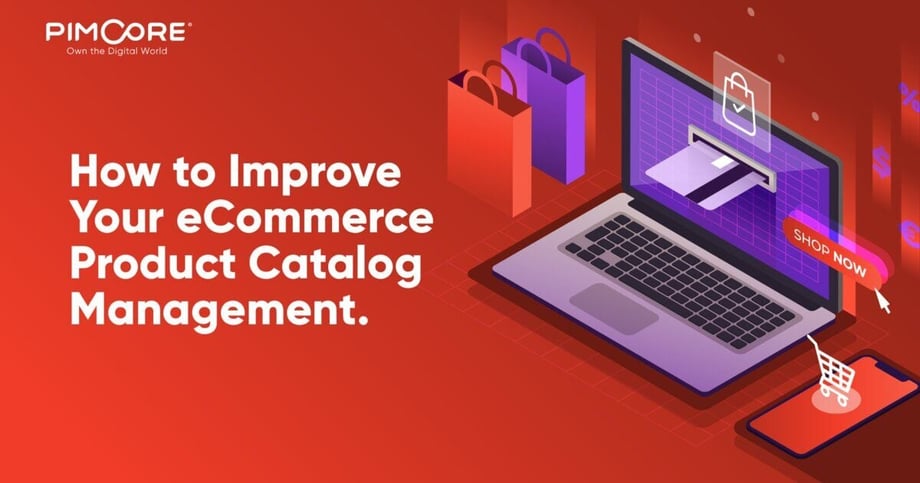
Produktkataloge spielen eine immer wichtigere Rolle bei der Verbesserung des Online- und Offline-Kundenerlebnisses. Aber ihre wahre Stärke liegt in ihrer Fähigkeit, die Lebendigkeit und Anschaulichkeit von Produkten zu verbessern, so dass die Verbraucher sich die Produkte besser vorstellen können.
Die Bedeutung von Produktkatalogen für die Verbesserung der Online- und Offline-Konsumentenerfahrung nimmt stetig zu. Ihre wahre Stärke liegt jedoch in ihrer Fähigkeit, die Lebendigkeit und Anschaulichkeit von Produkten zu verbessern, so dass die Verbraucher sich die Produkte besser vorstellen können. Sie verbessern die Nutzungserfahrung von Produkten und machen sie sehr einflussreich, um Käufer anzuziehen und Interessenten während des Kaufprozesses zu überzeugen.
Aber im Laufe der Jahre ist die manuelle Verwaltung von Produktkatalogen zu einer mühsamen und zeitraubenden Aufgabe geworden. Unternehmen stehen bei der Verwaltung ihres eCommerce-Produktkatalogs aus folgenden Gründen vor vielen Herausforderungen:
- Verwaltung mehrerer Quellen für Produktinformationen
- Koordination und Zusammenarbeit mit verschiedenen Teams und Mitwirkenden
- Verwaltung verschiedener Katalogversionen für mehrere Kanäle (z. B. Web- und Mobilversion von Produktdaten)
- Handhabung mehrerer Sprachen und Währungen
- Bearbeitungs-, Genehmigungs- und Veröffentlichungsrechte vereinfachen
- Verwaltung verschiedener Versionen und Änderungskontrolle
- Einführung neuer Produktdaten und Kataloge
Wenn Sie nicht über die richtige Strategie für die Verwaltung von eCommerce-Katalogen verfügen, werden Ihre Produktdaten unübersichtlich und inkonsistent. Dies wirkt sich auch auf die betriebliche Produktivität, die Datenqualität, das Produkterlebnis und den Umsatz aus. Wenn Sie sich mit Websites, E-Commerce-Plattformen, Printkatalogen, E-Commerce, Verkaufsstellen, mobilen Anwendungen und mehr befassen müssen, wird die Herausforderung noch größer.
Best Practices für die Verwaltung von eCommerce-Produktkatalogen
Produktkataloge sind heute ein Massengeschäft. Wenn Sie nicht die besten Praktiken für das eCommerce-Produktkatalogmanagement anwenden, können Sie sich in einem Labyrinth aus inkonsistenten und unzuverlässigen Produkterfahrungen verfangen. Sie sind dann Ihren manuellen Bemühungen ausgeliefert, was bedeuten kann, dass Sie viel wertvolle Zeit und Ressourcen riskieren. Hier sind einige Faktoren, die Sie beachten sollten:
1. Relevanz und Glaubwürdigkeit der Produktdaten
Minderwertige und unvollständige Produktdaten können für Ihre eCommerce-Strategie gefährlich sein. Sie müssen stets die Qualität und Genauigkeit Ihrer Produktinformationen sicherstellen, damit potenzielle Kunden Ihren Marken vertrauen und immer wieder kommen. Sie müssen umfassende und aktuelle Informationen über Ihre Produkte bereitstellen. Die richtigen Informationen ermöglichen es Ihnen, einen genauen Produktkatalog für Ihre Marken zu erstellen, wann und wo immer Sie ihn benötigen.
2.Klare Kategorisierung und Angabe der Produkteigenschaften
Eine klar definierte Produktkategorie ist im eCommerce-Geschäft unerlässlich. Sie müssen alle Spezifikationen der Produkte hinzufügen, damit ein gut gestalteter Produktkatalog erstellt werden kann. Alle Informationen wie Produktgröße, Farbe, Preisschilder und andere Attribute müssen klar definiert sein. Sie müssen einige unterstützende, aber relevante Spezifikationen zu Ihrer Produktbeschreibung hinzufügen. Viele Produkte können zu mehreren Kategorien gehören. Wenn der Katalog Hunderte von Millionen von Produkten enthält, sind Kategorisierung und Klassifizierung unerlässlich. Eine gut definierte Produktklassifizierung stärkt die Benutzerfreundlichkeit und verbessert die Suchrelevanz.
3. Unterscheidung zwischen physischen und digitalen Katalogen
Physische und digitale Kataloge sind in der Regel etwas anders beschaffen. Am besten ist es, wenn Sie klar unterscheiden, welche Informationen in Offline-Katalogen und welche Informationen in Online-Katalogen enthalten sein sollten. Das Publikum für beide Arten von Katalogen kann sich unterschiedlich verhalten. Sie müssen sich auf das Verhalten Ihrer Kunden (online und offline) einstellen und dann kontinuierliche, angeborene Produktwerte liefern.
4. Personalisieren Sie Ihre Produktkataloge
Personalisierung ist einer der entscheidenden Faktoren bei der Erstellung von Produktkatalogen. Sie können nicht die gleichen Dinge an verschiedene Zielgruppen liefern. Denken Sie an verschiedene Faktoren wie Produktpreise, Mengen und andere Attribute, um Ihre Zielgruppe mit der richtigen Art von Katalog anzusprechen. Sie müssen Ihre Produktkataloge segmentieren, um ein personalisiertes und nahtloses Kundenerlebnis über alle Berührungspunkte hinweg zu bieten.
Investieren Sie in die richtige PIM-Plattform
Produktinformationsmanagement-Systeme (PIM) sind die ideale Wahl für die Verwaltung von eCommerce-Produktkatalogen. Mit einem PIM-System können Sie alle Ihre Produktdaten an einem einzigen Ort zentralisieren und verwalten. Mit PIM-Software können Sie alle Ihre Produktkataloge und die zugehörigen Marketing-, Vertriebs- und technischen Produktdaten harmonisieren. Mit dem automatisierten Prozess zum Hochladen, Standardisieren und Veröffentlichen Ihrer Produktkataloge für Ihre verschiedenen Vertriebskanäle können Sie Zeit sparen. Sie können sicherstellen, dass Sie immer über umfassende, konsistente Produktinformationen verfügen, nach denen Ihre Kunden suchen.
- Import und Onboarding von Daten: Zentralisieren Sie alle Produktinhalte und -informationen aus verschiedenen Quellen (Excel/CSV, ERP, PLM, Lieferanten und Marketing) mit benutzerdefinierten Produkthierarchien, Datenmodellierung, Validierungen und Versionierung.
- Digitalisieren und Optimieren von Produktkatalogen: Erstellen und organisieren Sie Kataloge mit umfassenden Informationen wie Produktbeschreibungen, Bildern, Videos, Spezifikationen, Attributen, Zubehör, Teilen und mehr.
- Anreichern von Produktkatalogen: Gestalten Sie Ihre Produktkataloge höchst intuitiv mit detaillierten Produktinformationen, um die Konversionsrate zu erhöhen.
- Syndizieren und verteilen Sie in Echtzeit: Exportieren und veröffentlichen Sie Daten in verschiedenen Formaten über mehrere Kundenkontaktpunkte, andere Vertriebspartner, Lieferanten und Agenturen mit branchenüblichen Datenpools.
- Druckprozess automatisieren: Erstellen Sie personalisierte druckfertige Marketing- und Vertriebsunterlagen wie Preislisten, Broschüren, technische Dokumentationen und aktuelle Präsentationen auf Knopfdruck.
Die Fähigkeit Ihrer Marke, die Verbraucher zu überzeugen und emotionale Bindungen zu wecken, indem sie kreative und ästhetische Anreize nutzt, ist ein entscheidender Wettbewerbsvorteil im modernen eCommerce. Produktkataloge können ein starker Katalysator sein, um dies zu erreichen.
Wollen Sie wissen, wie Sie das richtige PIM-System für die Verwaltung Ihrer eCommerce-Produktkataloge auswählen? Vereinbaren Sie eine Demo mit den Pimcore-Beratern.
Holen Sie sich eine KOSTENLOSE Demo!
Verbundene Einblicke:
- Die Kunst der erfolgreichen Produktpromotion mit effektivem Produktkatalogmanagement
- Produktkatalogmanagement- Warum es unverzichtbar für den Erfolg im Einzelhandel & eCommerce ist
- 8 Key Reasons Why PIM Is Key to Your Digital Commerce Success
- Wie PIM CPG-Unternehmen hilft, inmitten unsicherer Zeiten und Marktschwankungen zu wachsen?


